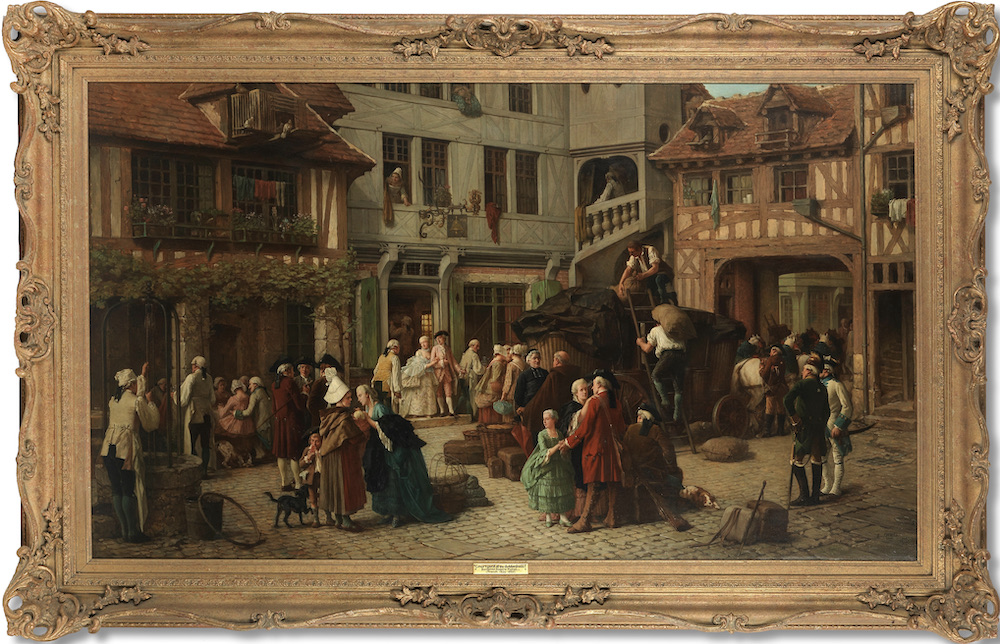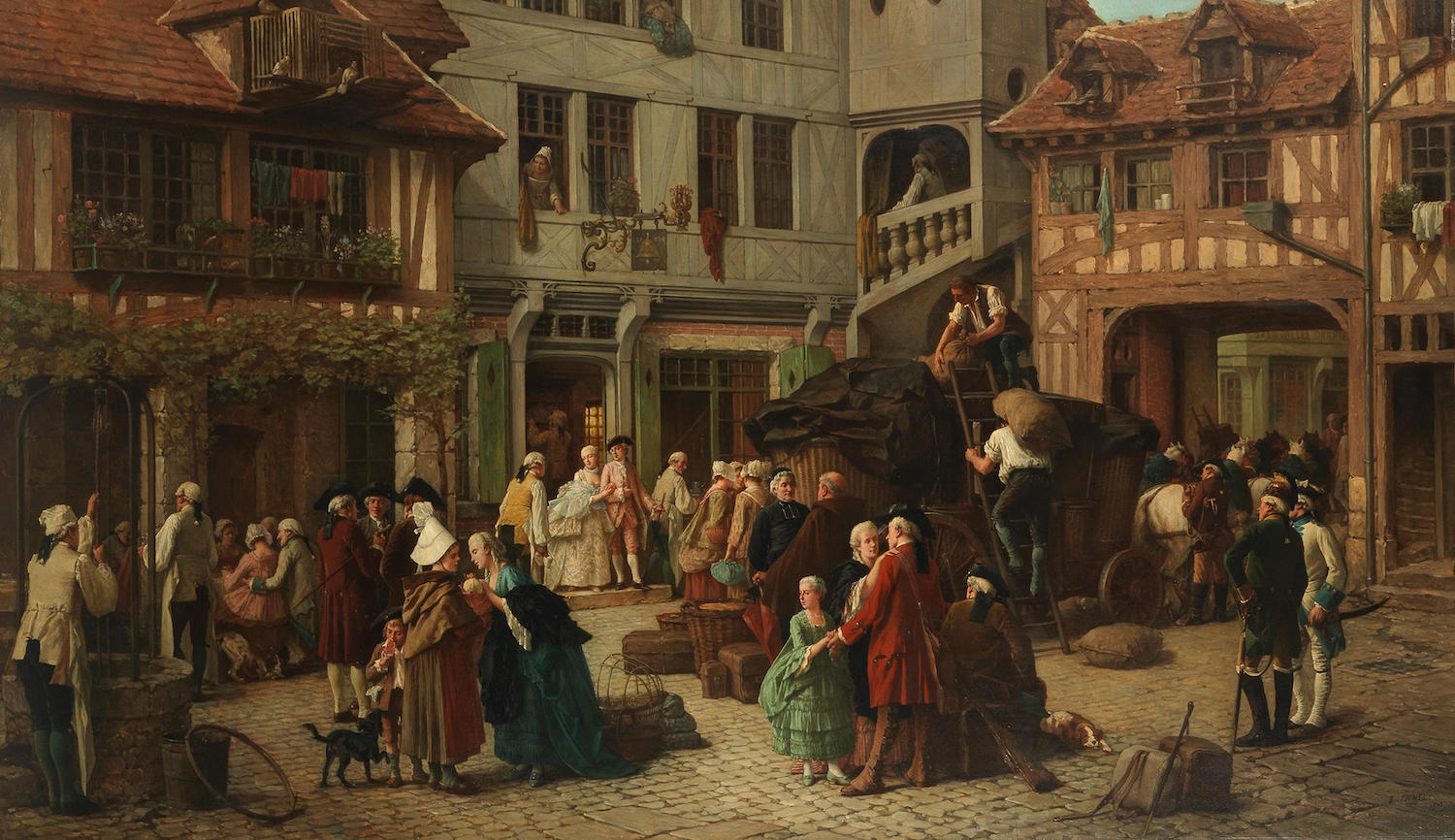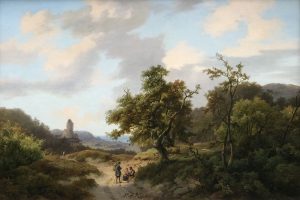Description
Benjamin Eugène Fichel (Paris, 1826 – 1895)
The courtyard of the Golden Bell, France
Material: Oil on panel
Dimension: 78 x 134,5 cm
Frame: Yes
Dated: 1875
About the Artist:
B. Eugène Fichel was born on August 30th, 1826 in Paris. A talented young artist, he entered the École des Beaux-Arts at the young age of fifteen, where he eventually became a student of Martin Drolling and Paul Delaroche, the latter a winner of the Prix de Rome and whom he would most consistently cite as his master. Given his very young age and the rigorous training necessary as a student of the École des Beaux-Arts, Fichel did not exhibit his first painting until the 1849 Parisian Salon, where he showed Sainte Famille (Holy Family), Portrait de Hadji-Add-Hamid-Bey (Portrait of Hadji-Add-Hamid-Bey), and Portrait de M.L. (Portrait of M.L.). Fichel became a prolific Salon artist, beginning with many portraits, but later exhibiting, consistently and unwaveringly, historical and genre scenes inspired by the eighteenth century. Fichel chose to submit many historically-oriented works to the Salon, at that point considered the most elevated subject matter, such as his 1867 Salon entry “Ouvrez au Nom du Roi” (“Open in the Name of the King”). As his Salon career progressed, Fichel began submitting more often the types of intimate genre scenes influenced by Dutch painting, such as his 1883 Joueurs des Cartes (Card Players) and his 1888 Le Dejeuner (The Luncheon).
Many of Fichel’s historically-oriented themes were those depicting episodes from the reign of Napoleon I. Louis Auvray, a nineteenth century art critic, took notice of Fichel’s 1865 Salon entry, L’Empereur Napoleon Ier Combinant des manœuvres (Palais de Compiègne) (The Emperor Napoleon I Combining Maneuvers (Compiègne Palace)), which was purchased by Princess Mathilde, Napoleon I’s niece. Auvray explains that Fichel’s (Exposition des Beaux-Arts : Salon de 1865, Paris: A. Levy, Fils, 1864, pg. 69): “Effect of this composition is imposing ; the severity of coloring is well in harmony with the calm that reigns in the study where the great captain contemplates in silence the plan of a new campaign and of new victories, while further away his secretary is absorbed in the expedition of numerous dispatches. Everything in this canvas is rendered with a care and a talent that leaves nothing to be desired”.
Miniatur Genre
While critics took notice of Fichel’s contributions to the annual Salons, it was Fichel’s similarities to another artist of high stature, Ernest Meissonier, that drew the majority of the comparisons. Since Meissonier was considered by some to be “the first French artist to become celebrated in miniature genre,” and “the most conspicuous artist of the entire French school,” (C.H. Stranahan, A History of French Paintings, New York: Scribner’s & Sons, 1888, pg. 335), it is natural that many later artists with similar stylistic propensities would fall under the banner of the “school” of this master. Many contemporary accounts of Fichel’s work do not concentrate exclusively on Fichel’s production, but more so at his relation to the work of this artist. The two men often treated very similar themes, notably the artist in his studio, a prominent inclusion in both artists’ production, in addition to historical scenes, each looking back to the eighteenth-century historical and genre scenes.
This proved to be both positive and negative, for while Fichel was being linked with a very successful and popular genre painter, Meissonier, his work seemed to be overshadowed by this great master. Eric M. Zafran, in his exhibition catalog Cavaliers and Cardinals: Nineteenth-Century French Anecdotal Paintings (pg. 42), noted that “[a]s one Salon critic aptly observed, there were many ‘victims’ of Meissonier, but of these another critic found Fichel was the one ‘who by his delicate and fine touch and the irreproachable correctness of his line came the closest to Meissonier.’” Zafran states that it was further noted that Fichel was, “one of Meissonier’s most distinguished imitators.” Louis Auvray also commented on this similarity in his Salon de 1865 (pg. 69), noting the differences between Fichel’s paintings and those of Meissonier, remarking that Fichel’s were “of a more severe color, of a more steady drawing,” which, “are more suitable to historical subjects of which Mr. Fichel has for some time given his preference.”
Parisian Salon
During his career at the Parisian Salon, Fichel was awarded several awards and continued to exhibit there until his death in 1895. He was awarded a third class medal in 1857 for Une Matinée Dramatique (A Dramatic Morning), a portrait painting, and two other works; a mention in 1861 for several works including La Première Leçon d’Armes (The First Weapon Lesson), Chanteurs Ambulants Dans un Cabaret (Traveling Singers in a Cabaret), and Baptême de Mlle Clairon (Baptism of Mlle Clairon); a medal in 1869 for La Nuit de 24 août 1572, avant les massacres (The Night of August 24th, 1572, before the massacres), and Le Fou qui Vend la Sagesse (The Insane who sells Wisdom) – based on a fable by La Fontaine; and a silver medal at the 1889 Exposition Universelle. He finalized his exhibition career with Au Café (At the Café) and Partie des Dames (Ladies’ Departure). Fichel achieved one of his highest honors in 1870 when he was named a Knight of the Legion of Honor. At the end of his career he had achieved, “an envied place among the genre painters of the French school of the nineteenth century.” (Zafran, 42). He died in 1895 in Paris.
Works in Museums
Fichel’s work is a reflection of many of the values in academic art of the nineteenth-century: reliance on the tutelage received at the École des Beaux-Arts, adherence to the principles of flawless execution, treatment of varied historical themes, and an interest in both eighteenth-century themes and those reminiscent of Dutch masters – found in both historical and genre scenes. Though often overshadowed by Meissonier, Fichel’s accuracy of detail, love for rich colors, and interest in perpetuating an interest in the eighteenth-century deserves merit outside of his relationship to other artists of his period. Fichel’s work can be found in many of France’s museums, including the Musée Magnin and the Musée des Beaux-Arts in Dijon, and the Musées des Beaux-Arts in the cities of Lille, Rennes, Rouen, and Bordeaux. Two of his paintings, “A Violin Player,” executed in 1871, and “Awaiting an Audience,” painted in 1881, are in the New York Metropolitan Museum of Art.




